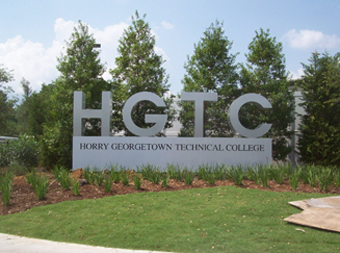 When it came time for schools across the country to head back into session, one sign company had to “brush up” on its brushed aluminum education to complete a build-and-install monument project.
When it came time for schools across the country to head back into session, one sign company had to “brush up” on its brushed aluminum education to complete a build-and-install monument project.
Horry Georgetown Technical College is a two-year college located in Conway, South Carolina that has been around since the 1960s. But school officials didn’t require textbooks to figure out that they needed standout identity signage today that would not only enhance the campus but also act as a landmark for the future.
The college opted for a pair of similarly designed monument signs that would be set up at two different entrances to its facilities—signs featuring the letters “HGTC” standing on a pedestal base.
Since there was a possibility of students wanting to climb onto these monument letters, the college knew it was going to need something super-durable. Originally the idea was to use granite.
However through subsequent meetings with General Contractor Rick Ruonala of TLR Construction Co., Inc., in Myrtle Beach, South Carolina and Architect Patrick Williams of SGA Architecture in Pawleys Island, South Carolina, the school decided all-brushed aluminum would look—and work out—better.
The twenty-four-inch-deep, non-illuminated HGTC letters are grouped twenty feet across the pedestal. Each letter stands four-and-a-half feet tall on the forty-two-inch high pedestal base. From the top of the letters to the bottom of the base, the entire monument measures eight feet tall.
The company that built and installed these signs was Rite Lite Signs, a full-service sign business located in Concord, North Carolina that has thirty employees (including designers, fabricators, and installers) and a penchant for working on custom builds.
Interestingly Rite Lite wasn’t the original sign shop hired for this project. When the job was up for bidding, they had made it to the final stage but lost out to another company by just a couple thousand dollars.
However this bidding took place when the two signs were still going to be granite. As fate would have it, the school’s decision to switch to brushed aluminum actually worked out in Rite Lite’s favor.
“The original sign company couldn’t figure out how to do the returns and the brushed aluminum. They were just planning to paint it,” says David Cornelius, account manager at Rite Lite Signs. “So a couple of weeks into it, they bowed out.
“[School officials] got back in touch with us and asked if we could do it. Of course, we told them, ‘Yes!'”
Rite Lite had worked on its fair share of monument projects over the years, but the shop hadn’t worked on any that would use brushed aluminum (especially at this size). They internally started to wonder if they hadn’t bitten off more than they could chew, especially when trying to figure out why the other shop would give up and opt out.
{2j_imageviewer 18}
“The school wanted everything to be 1/4-inch plate brushed aluminum,” says John Sullivan, vice president of operations at Rite Lite, “which we were able to do, except for the returns of the letters. Those we made out of 1/8-inch brushed aluminum.”
Rite Lite Lead Fabricator/Structural Designer Eric Wray and Production/Installation Manager Robert “Boomer” Frazier devised a game plan for construction of the 8-by-20-foot brushed aluminum monument, and Senior Project Manager Renae Hartsell scheduled this project for go-ahead.
Art Director Brian Goss provided the layouts, and Rite Lite custom-built the faces and backs of the letters out of 1/4-inch aluminum using their CNC router. “We also constructed an interior framework made from 3/16-inch aluminum to hold it all together and give us something to weld to,” explains Sullivan.
There are no visible fasteners on the front side of the letters. Stainless steel countersunk screws attach the backs to the returns. The backs were made removable here in order to access letter mounting.
After assembling and welding the letters, Rite Lite Master Paint Technician Benny Culler applied several layers of clear-coat to them. “With the sign being heavy and brushed aluminum, I had to be extremely careful in handling the product to make sure there were no defects before I applied any of it,” he says.
The pedestal base is made from 3/16-inch brushed aluminum in a vertical grain direction. School officials requested that the letters be detachable from the base. “This way, they can go to the back of the letters and unbolt each letter independently and haul it away, if they need to do repairing or refinishing down the road,” explains Sullivan. (Note: The base features a seam between the “H-G” and “T-C” letters, so it can also be removed at this division.)
The black lettering on the pedestal base is a bit of optical illusion. Sure they may look like stud-mounted acrylic or plastic letters, but they’re not.
Instead Rite Lite Signs waterjet-cut the letter copy out of a 1/4-inch aluminum panel and attached this panel to a 1/8-inch aluminum backing, which was then painted black. “It’s a relief-cut letter appearing to be dimensional and black,” says Sullivan. “It’s kind of the reverse of a 1/4-inch plate letter. That gives it a cool, unique effect.”
Each of the letters is attached to the pedestal base via stainless steel countersunk screws. Two were used for each end of the “H,” and two each for the remaining letters.
Rite Lite Lead Installer Tim Shaffer anchored the pedestal to the ground via two six-inch steel square tubes. The tubes were inserted in pre-drilled slots, spaced nine feet apart, and welded at their tops. Meanwhile there are two concrete foundation pads and footers at the bottom of each end of the pedestal that was built by TLR Construction.
As you might expect from thick, brushed aluminum letters and a pedestal base of this size, these signs are very, very heavy. Installation required the use of Rite Lite’s cranes. “We installed the base first and then attached the letters to the base when we got to the job site,” says Sullivan. “We then bolted down each letter.”
Rite Lite didn’t have to do much excavation. One of the signs was installed in an open space that required the use of pavers, while the other was set up in a landscaped area. “The landscapers were working around us, as we were installing that sign,” says Sullivan.
{2j_imageviewer 19}
It took five weeks to build both signs, and installation covered a couple of trips back-and-forth to the shop over a week. “We had to first set the steel and then bring back the base and then the letters,” says Sullivan.
One of the biggest challenges here was dealing with the brushed aluminum finish featured on the entire sign. “You had to completely protect every little piece every step of the way,” explains Sullivan.
When it was lying on a table, Rite Lite would add a thin layer of foam to protect it. They also had to watch the heat when welding on the 1/4-inch aluminum plate so it wouldn’t burn through and discolor it. “Handling was a major consideration, because you could easily bump something and the whole side of the sign could be marred,” says Sullivan, “so that was very touchy.”
Another big challenge was scheduling. The school was eager to have the signs in place by the time sessions began again in the fall, and Rite Lite had already lost a bit of time here due to the other sign company dropping out. “We had two days to turn around very detailed shop drawings,” says Cornelius. “We really had to ‘turn and burn’ as far as getting it approved and everything.”
In the end, Rite Lite passed this test and managed to school everyone in the art of putting together signs of this size and scope in a crammed period of time.
—Jeff Wooten











